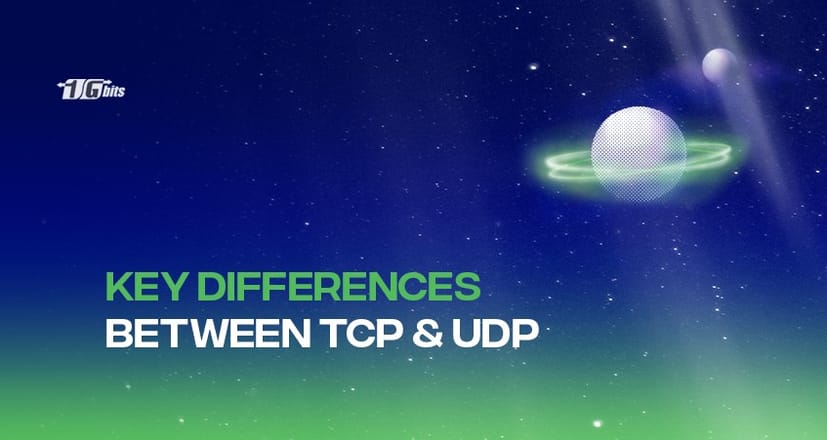If you are using a VPN on your system, you probably have already heard about the TCP and UDP protocols. Is there a difference between TCP and UDP when both protocols are used to send data packets over the internet?
Both TCP and UDP forward data packets using different ports of your router from your system to the final destination. Consumers can pick between a TCP or UDP arrangement for commercial use and personal use in the realm of Internet protocol communication.
Both TCP and UDP have their sides in terms of benefits and flaws in their functionalities. Examine your IP demands to make an informed decision on which protocol is best for you.
However, here we’ve prepared a complete guide while pointing out the differences between TCP vs UDP protocols. Have a look to weigh your options and choose the best one.
What is TCP?
The Link-oriented Transmission Control protocol (protocols) may be transmitted in two directions once a connection is established. To ensure that data is sent in the order that it has been dispatched, TCP contains built-in systems to check for faults and is the optimal protocol for transporting information such as photos, data files, and web pages.
However, while TCP's feedback systems are inherently dependable, they lead to higher overhead to increase the available network resources.
What is UDP?
The User Datagram Protocol (UDP) is a more straightforward Internet protocol without any connection that requires error detection and recovery. You can't find any overhead for opening, maintaining, and closing the connection in the UDP. The data are continuously transmitted to the receiver regardless of whether the recipient receives the link.
While UDP does not work well for sending, viewing, or downloading an email, it is preferred for communicating in real-time, such as broadcasting or multitasking network transfer.
What are the key differences between TCP and UDP [TCP vs UDP]?
TCP is a protocol based on a connection, whereas UDP is a protocol without a link. What is the difference between TCP and UDP? Speed is a significant distinction between TCP and UDP because TCP is relatively slower than UDP. UDP is a considerably faster, easier, and more efficient protocol, but it is possible to transmit lost data packets only with TCP.
Another key difference between TCP and UDP is the data transmission system. Unlike UDP, TCP offers an ordered data transmission from the user to the server. In contrast, UDP does not focus on communications from end to end to confirm the receiver's readiness (requiring fewer overheads and taking up less space).
Functionality differences in data transfer
TCP ensures that the byte stream from a user to the server is delivered reliably and orderly. UDP is not for end connections, and communication does not check recipient readiness.
Reliability
TCP is more dependable as it regulates the acceptance and transmission of messages if parts have been lost. So no data is missing at all. As no principles of recognition, time-out and broadcasting are provided, UDP does not verify communication has been reached by the receivers.
Order Sequence
Transmissions of TCP are transmitted in a series and received in the same sequence. TCP reorders and delivers the application when data segments come in an improper order. You can't preserve the message sequence when UDP reaches the recipient application. The order in which a message is received is entirely unpredictable.
Connection
TCP is a heavy-weight connection that requires three socket connectivity packets, controls congestion, and is dependable. UDP is an IP-designed lightweight transport layer. Tracking and sorting of messages are not available.
Transfer Method
TCP reads information as a byte stream and transmits messages to segment limits. UDP messages are independent packets, and their integrity is confirmed on arrival. There are defined limits for the containers, yet there is no data stream.
Detecting Error
UDP functions on the premise of "best effort." The protocol provides error detection, but the packet will be deleted if an error is identified. The packet retransmission is not tried to retrieve this error.
It is because UDP is generally for applications with time sensitivities such as gaming or voice transmission. Error recovery is useless as it will not use the retransmitted packet by the time it is received.
TCP uses error detection as well as error recovery. If a packet is incorrect, the recipient is not recognized, which causes the sender's retransmission.
The TCP and UDP Working Methodology:
The three-way and considered handshake are used to create a TCP connection, which initiates and recognizes the connection procedure. The transport of data can begin after the link is established. Once connected, all virtual circuits are closed off.
TCP and UDP differences
Some other significant differences between the UDP and TCP protocols are as follows:
- TCP is a protocol based on a connection, whereas UDP is a protocol without a link.
- The TCP speed is lower, and the UDP speed is quicker
- TCP employs SYN, SYN-ACK, and ACK handshake protocols while UDP does not use any hand-shake protocols
- TCP checks errors and also recovers errors, while UDP contains falsehoods but discards wrong packets. It does not correct errors.
- TCP has segments of recognition. However, UDP has no part of the recognition.
- TCP is heavy-weight while UDP is lightweight when comparing TCP to UDP protocol.
How does TCP function?
With a three-way handshake, a TCP connection is formed. It is a connection-building and recognition process. The data transfer begins when the connection is formed, and the relationship ends by close of an established virtual circuit after transmission processes are completed.
TCP characteristics
Some essential characteristics of TCP are here
- Recognitions for delivery
- Re-transfer
- Transmission delays when the network is blocked
- Easy detection of Errors
How does UDP function?
UDP utilizes a basic transmission technique for order, dependability, or data integrity without associated hand-shaking dialogues. UDP also assists in detecting the error inspection and fixation are not essential or carried out in the application to reduce the overhead of such processing at the network interface level. The multi-diffusion and packet broadcasts are the two other compatibilities of it.
UDP Characteristics
Some crucial features of UDP are as follows:
- Supports programs that tolerate packet loss that uses heavy bandwidth
- Less time consuming
- The bulk of packets is transferred.
- Data loss possibility
Conclusion
Thus, we have seen in detail the key differences between TCP and UDP as well as other important aspects related to these two protocols. You can choose between these two depending on your specific requirements as well as by considering the features of these two protocols.
People also read:







